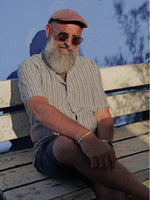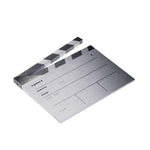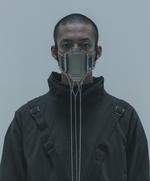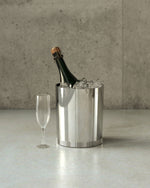28.04.20 in inspirations
The Archives Project - Erwan Le Louër


Co-founder of LE GRAMME and trained designer, the place of the object is central for Erwan Le Louër. He expresses all his passion for the object through his own collection of design and contemporary art called The Archives Project.
This collection reflects the immoderate taste of this entrepreneurial designer for minimal aesthetics and taut lines, his search for a creation which through its tension becomes a source of emotions.
How was The Archives Project born?
The Archives Project was carried out with passion, rigor and the desire to transmit. I built this collection to allow me to create a bond with my children about what drives me and fascinates me, but also to pass on to them a heritage that has meaning in relation to who I am, in the place that can having the object in my life, perhaps communicating to them my passion for aesthetics and the desire or not in turn to enrich it, to carry out their own handover.
What underlies this project is indeed this minimal aesthetic and these taut lines, whether it is photography of art objects or pieces of furniture. Over time, my project continues to grow with new works and new objects that I choose with passion. The only trigger for an acquisition is the emotion I will feel.
I am on permanent alert, an uncompromising rigor which has become a reflex, it inspires and nourishes me. For me, art and design were designed to be observed and experienced on a daily basis - some of my objects are in the Le gramme store or its offices - that's why I opened The Archives Project catalog with individuals or companies wishing to surround themselves with exceptional objects.
Your first acquisition?
A photo of Louise Lawler, acquired at the FIAC on impulse. Louise Lawler is an artist who works in the vein of appropriationism. I liked this idea of mise en abîme which consists of making the work of the other into a new work by taking a photo of it in its context (a museum, with collectors, during the assembly or dismantling of an exhibition ). This was a diptych by Richter. I was seduced by this minimal work in black and white, this angle of view which created an abstraction and the use of photography to show painting.
This collection reflects the immoderate taste of this entrepreneurial designer for minimal aesthetics and taut lines, his search for a creation which through its tension becomes a source of emotions.
How was The Archives Project born?
The Archives Project was carried out with passion, rigor and the desire to transmit. I built this collection to allow me to create a bond with my children about what drives me and fascinates me, but also to pass on to them a heritage that has meaning in relation to who I am, in the place that can having the object in my life, perhaps communicating to them my passion for aesthetics and the desire or not in turn to enrich it, to carry out their own handover.
What underlies this project is indeed this minimal aesthetic and these taut lines, whether it is photography of art objects or pieces of furniture. Over time, my project continues to grow with new works and new objects that I choose with passion. The only trigger for an acquisition is the emotion I will feel.
I am on permanent alert, an uncompromising rigor which has become a reflex, it inspires and nourishes me. For me, art and design were designed to be observed and experienced on a daily basis - some of my objects are in the Le gramme store or its offices - that's why I opened The Archives Project catalog with individuals or companies wishing to surround themselves with exceptional objects.
Your first acquisition?
A photo of Louise Lawler, acquired at the FIAC on impulse. Louise Lawler is an artist who works in the vein of appropriationism. I liked this idea of mise en abîme which consists of making the work of the other into a new work by taking a photo of it in its context (a museum, with collectors, during the assembly or dismantling of an exhibition ). This was a diptych by Richter. I was seduced by this minimal work in black and white, this angle of view which created an abstraction and the use of photography to show painting.
“what underlies this project is indeed this minimal aesthetic and these taut lines, whether it is photography of art objects or pieces of furniture. »

The work you hold most dear?
It's a close up of architecture, the detail of a light fixture in an industrial hangar taken by Ludovic Parisot, my best friend who died in 2016. Beyond our friendship, our appetite for a common aesthetic brought us together, our immoderate taste for the tension of lines and radicality. She's at my house, and if I had to choose just one, it would be her.
The work that shook you the most?
There is none, because I reason with passion, I do not make any acquisitions in a fundamentally reasoned way, my relationship with art cannot be calculated. The work that shook me the most is actually not in my collection, it was the first time that I did not listen to my passion, that I started to reason and ask myself certain questions, I therefore missed it and I regret it, but the lesson remains because without it, I would perhaps not have anchored the conviction to choose my acquisitions according to the emotion they give me.
It's a close up of architecture, the detail of a light fixture in an industrial hangar taken by Ludovic Parisot, my best friend who died in 2016. Beyond our friendship, our appetite for a common aesthetic brought us together, our immoderate taste for the tension of lines and radicality. She's at my house, and if I had to choose just one, it would be her.
The work that shook you the most?
There is none, because I reason with passion, I do not make any acquisitions in a fundamentally reasoned way, my relationship with art cannot be calculated. The work that shook me the most is actually not in my collection, it was the first time that I did not listen to my passion, that I started to reason and ask myself certain questions, I therefore missed it and I regret it, but the lesson remains because without it, I would perhaps not have anchored the conviction to choose my acquisitions according to the emotion they give me.

The one that looks most like you?
A black and white photo by Daido Moriyoma depicting the underside of an airplane. Because it expresses this form of radicality and rigor to which I aspire, through its structure, through the choice of black & white which often seduces me. I love photography because it captures moments and that's how life should be approached: capturing the moment, making it something memorable. This image resembles me, we don't really know if the plane is taking off or landing, what matters is that the object is in motion, that it is in a dynamic, like my projects.
The magnificent intruder in your collection?
The Katavolos T-Chair! For me, the meaning of an object, the destiny of an aesthetic is to serve a function, to be able to be used, to be part of everyday life. However, the structure, the height of these seats, neither low enough nor high enough, makes them dysfunctional although magnificent objects.
A black and white photo by Daido Moriyoma depicting the underside of an airplane. Because it expresses this form of radicality and rigor to which I aspire, through its structure, through the choice of black & white which often seduces me. I love photography because it captures moments and that's how life should be approached: capturing the moment, making it something memorable. This image resembles me, we don't really know if the plane is taking off or landing, what matters is that the object is in motion, that it is in a dynamic, like my projects.
The magnificent intruder in your collection?
The Katavolos T-Chair! For me, the meaning of an object, the destiny of an aesthetic is to serve a function, to be able to be used, to be part of everyday life. However, the structure, the height of these seats, neither low enough nor high enough, makes them dysfunctional although magnificent objects.
“this is how life should be approached: capturing the moment, making it something memorable. »







